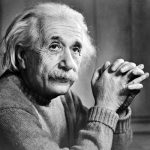 Science is the process of discovering nature’s secrets. In the sixteenth century, the introduction of the scientific method launched the Scientific Revolution, modernizing Western Civilization.
Science is the process of discovering nature’s secrets. In the sixteenth century, the introduction of the scientific method launched the Scientific Revolution, modernizing Western Civilization.
When Isaac Newton began his studies at Cambridge University in 1661, the revolution solved many of nature’s secrets. Understanding his place in the revolution, Newton noted –
“If I have seen further, it is by standing on the shoulders of giants.”
Newton credited his success to the principles of science developed by the pioneers of the Scientific Method at the Royal Society, primarily Francis Bacon (pictured left). In the twenty-first century, the Scientific Method remains the only proven process to scientifically validate the universal laws of nature.
Darwin’s Quest
As the Scientific Revolution continued to expand our understanding of nature, infinitely more intriguing questions lingered. One mystery, “the origin of species,” fueled Charles Darwin’s quest for a natural explanation.
In his Autobiography, Darwin asserted that he worked “on true Baconian [Scientific Method] principles and without any theory collected facts on a wholesale scale.”
theory collected facts on a wholesale scale.”
Behind the scenes, however, his notebooks and correspondence reveal a different story. In a personal letter, Darwin reversed his Baconian claim –
“How odd it is that anyone should not see that all observation must be for or against some view if it is to be of any service!”
With Bacon’s Scientific Method incapable of answering his quest, Darwin turned to the increasingly popular progressive philosophy approach. In a letter to American naturalist Asa Gray, Darwin noted –
“I am quite conscious that my speculations run quite beyond the bounds of true science.”
Scientific Processes
Since then, the field of science has developed processes to study broader aspects of nature while maintaining crucial Baconian principles.
With repetitive testing and observation with the same or equivalent results, the theory is recognized as scientifically valid within its statistical inference. A scientifically valid theory explains how nature behaves under specific conditions.
However, scientifically valid theories are distinctly different from natural laws. A scientific theory explains how a natural phenomenon may occur but cannot predict when it will happen.
 By contrast, a natural law consistently and universally describes how and predicts the occurrence of a future natural phenomenon. For example, Albert Einstein’s (pictured right) mass-energy equation, E = mc2, is universally consistent and predictive.
By contrast, a natural law consistently and universally describes how and predicts the occurrence of a future natural phenomenon. For example, Albert Einstein’s (pictured right) mass-energy equation, E = mc2, is universally consistent and predictive.
Once validated using the Scientific Method, natural laws hold science’s highest confidence level. However, science is a repetitive and cyclical process of testing and evaluating to refine further our understanding based on the evidence. In the words of Einstein –
“No amount of experimentation can ever prove me right; a single experiment can prove me wrong.”
Modern Science Branches
Modern science has three branches: the natural sciences, the formal sciences (e.g., mathematics), and the Social Sciences. The natural sciences encompass the physical sciences and the life sciences. Chemistry, physics, geology, and astronomy comprise the major physical sciences, while the life sciences include biology.
Evolutionary biology, however, is unique. Although primarily within the subfield of life sciences, the study of evolution also reaches into the physical and historical sciences. Therefore, a comprehensive scientific study of biological evolution requires different study methods.
The “Scientific Method”
Science is a systematic process of studying nature using scientific principles. These principles include objective observation, formulation of hypotheses, testing, data collection, analysis, evaluation, and repetitive falsification testing. Science objectively seeks answers to questions about the universe.
The “Scientific Method” is science’s cornerstone for investigating nature’s laws. Often expressed mathematically, this method precisely describes, predicts, and validates nature’s laws that drive universal patterns and regularities of the past, present, and future.
However, what is known about the laws of biology is that they are not universal; biological realms are unique and distinct. Therefore, since biology and physics are distinctly different natural science fields, each has unique study methods.
Modern Science Study Approaches
Since the publication of The Origin of Species, scientists have re-engineered the “Scientific Method” to study the laws of Earth’s biosphere using empirical and experimental approaches. The introduction of these research approaches revolutionized our understanding of the biology sciences.
Empirical Research
Empirical research aims to describe observable and measurable characteristics of nature. This approach addresses the “what” question; it does not directly address cause-and-effect relationships. Studying current and past events is known as descriptive and historical empirical research.
While descriptive research aims to describe characteristics of current natural phenomena, historical research aims to describe past natural phenomena.
Descriptive Empirical Approach
 The descriptive empirical research approach is the most frequently applied method throughout the biological sciences, from basic biology to healthcare.
The descriptive empirical research approach is the most frequently applied method throughout the biological sciences, from basic biology to healthcare.
Bernard Kettlewell’s groundbreaking 1950s study on the effects of pollution on the populations of peppered moths (pictured right) demonstrated that birds selectively preyed on moths based on their coloration relative to the color of their environmental background.
The study became a cornerstone of biology education, illustrating the principles of evolution and adaptation (microevolution).
Historical Empirical Approach
The fossil record, traces of ancient life, is the only direct evidence of life on early Earth. Therefore, fossils are crucial in understanding the history of life on Earth, a field of study known as paleontology.
Greek philosophers gained recognition of the field by concluding that fossil seashells found on land must have been once underwater. The field exploded along with global travel from Western Europe.
In the late eighteenth century, French naturalist Georges Cuvier demonstrated paleontology as a scientific discipline. In the early nineteenth century, William Whewell, a Fellow of the Royal Society, gained recognition for paleontology as a historical science, along with archaeology, geology, and astronomy.
Following the publication of The Origin of Species, an insatiable interest in paleontology continued to escalate. Modern technology allows access to biology’s vast complexity—even molecular biology.
The fossil search for evidence of Darwin’s intermediate and transitional links is the ultimate scientific test to validate the theory of evolution.
Experimental Research Approach
Experimental research is more rigorous than empirical research. While empirical research relies on measured observations, experimental research requires controlled experiments to test the hypothesis.
This approach aims to understand cause-and-effect relationships by manipulating variables in controlled conditions to directly address an observed phenomenon’s how, why, or when. It most resembles the scientific method.
Natural selection is evolution’s proposed mechanism driving the “origin of species,” therefore, performing experimental research is critical for scientifically validating the theory of evolution.
Experimental Testing
 In 1988, a professor at Michigan State University, Richard Lenski, launched evolution’s longest-running experimental research project using the bacteria Escherichia coli (E. coli).
In 1988, a professor at Michigan State University, Richard Lenski, launched evolution’s longest-running experimental research project using the bacteria Escherichia coli (E. coli).
By manipulating flask environmental factors (pictured right), while Lenski continued to observe adaptation (microevolution), evidence for E. coli transitioning from adaptation to speciation (macroevolution) has not been observed.
By 2018, Lenski’s experiment, known as the long-term evolution experiment (LTEE), reached a milestone. Writing for Science Alert, Fiona MacDonald puts the comparison between bacteria and human evolution into context –
“Scientists have spent the past 30 years carefully tracking evolution across more than 68,000 generations of E. coli bacteria – the equivalent of more than 1 million years of human evolution.”
What is Science, Then?
 In his Autobiography, Darwin asserted that he worked “on true Baconian [Scientific Method] principles and without any theory collected facts on a wholesale scale.” At the time, naturalists did not understand that biological natural laws differed from those applied in physics.
In his Autobiography, Darwin asserted that he worked “on true Baconian [Scientific Method] principles and without any theory collected facts on a wholesale scale.” At the time, naturalists did not understand that biological natural laws differed from those applied in physics.
Science is a process for discovering nature’s secret laws. But unlike physics, natural laws in biology are unique – not universal. Since the types of rules governing the fields of biology and physics differ, their scientific study approaches differ.
Studying Evolution and What Is Science? are subcategories of Understanding Evolution.
More
Science Study Methods is a subcategory of What is Science? The subcategories of Science Study Methods include –
Darwin Then and Now is an educational resource on the intersection of evolution and science, highlighting the ongoing challenges to the theory of evolution.
Move On
Explore how to understand twenty-first-century concepts of evolution further using the following links –
-
- The Understanding Evolution category showcases how varying historical study approaches to evolution have led to varying conclusions. Subcategories include –
- Studying Evolution explains how key evolution terms and concepts have changed since the 1958 publication of The Origin of Species.
- What is Science (current page) explains Charles Darwin’s approach to science and how modern science approaches can be applied for different investigative purposes.
- Evolution and Science feature study articles on how scientific evidence influences the current understanding of evolution.
- Theory and Consensus feature articles on the historical timelines of the theory and Natural Selection.
- The Biography of Charles Darwin category showcases relevant aspects of his life.
- The Glossary defines terms used in studying the theory of biological evolution.
- The Understanding Evolution category showcases how varying historical study approaches to evolution have led to varying conclusions. Subcategories include –
mc4wp_form id=”11069″]



